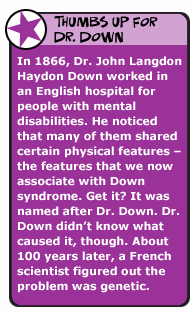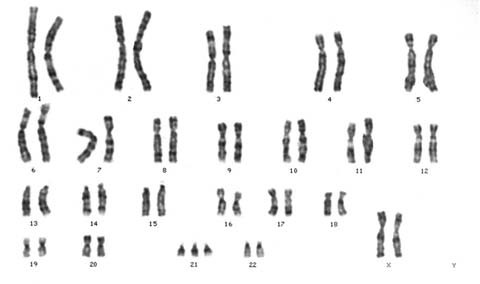
You hear those two words 'Down Syndrome' - what images do those two words conjure up in your mind? What do the people you have seen around in your community who have obvious signs of DS look like? sound like? and what are they doing? Even though DS is very common in our community, every 1 in 800 births, there is still the need to de-mystify it and there is a need to educate to take away the stigma associated with it.

|
So what exactly is Down Syndrome? |
Put very simply if a baby has Down Syndrome then they have one extra chromosome in each of their millions of cells. Instead of 46 chromosomes, a Down Syndrome baby has 47 (an extra number 21 chromosome). This additional chromosome, because of the genes it contains causes an excessive amount of certain proteins to be formed in the cell. This disturbs normal growth in the body of the fetus e.g. the baby is smaller, brain development is affected, heart defects occur. It affects boys and girls equally and is one of the most common birth defects.
|
Types of Down Syndrome |
There are three types of Down Syndrome:
1) Trisomy 21
Ninety-five percent of babies with Down Syndrome have Trisomy 21. This means that every cell of the baby's body has the extra chromosome. It results from one of the parents giving two number 21 chromosomes, rather than the usual one, to the child through the egg or the sperm.

2) Translocation
Around four percent of babies' Down Syndrome is due to the presence of an extra part, rather than the whole, of chromosome 21. This occurs when the small top portions of chromosome 21 and another chromosome break off, and the two remaining portions stick to one another at their exposed ends. Chromosomes 13, 14, 15, 22 or another 21 are involved. Chromosome 14 is the most common.
3) Mosaicism
Around one percent of babies' Down Syndrome is due to a faulty cell division which occurs in one of the earliest cell divisions after fertilization. This is in contrast to other types of DS when the mistake in cell division occurs at or before fertilization. As a result not all the cells have the extra chromosome, and the baby may have fewer of the usual physical features as well as higher intellectual abilities.
|
Characteristics of Down Syndrome |
There are more than 50 listed clinical characteristics associated with Down Syndrome. A baby will not display all of them. Here are some of the more common characteristics:
* poor muscle tone
* hyperflexibility (excessive ability to extend the joints)
* asymmetrical or odd-shaped skull, round head with flat area at the back of the head, small skull
* slanting eyes which may have folds of skin at the inner corners (called epicanthal folds) and small white flecks on the iris (Brushfield spots)
* flattened nose
* small or misshapen, low-set ears
* small mouth with protruding tongue
* short neck
* broad short hands and fingers
* single crease on the palm of one or both hands
* broad feet with short toes
* 'sandal toes' - a large space between the big toe and the second toe
* short, high-pitched cries in infancy
* slower growth and development (smaller in size)
* delayed mental and social skills (intellectual impairment)
(It is important to note that not all people with Down Syndrome look alike).
|
Health Issues Associated with Down Syndrome |
Associated with Down Syndrome are specific health-related problems such as:
* A lowered resistance to infection
* Respiratory problems
* Visual problems e.g. short-sightedness, long-sightedness, cataracts, squints
* Mild to moderate hearing loss
* Speech difficulty
* Heart defects
* Gastrointestinal tract problems e.g. blockages and constipation
* Reflux
* Atlantoaxial Instability which is a misalignment of the top two vertebrae of
the neck
* Obesity
* Leukemia and other blood related disorders
* Diabetes
* Celiac Disease
* Epilepsy
* Obstructive Sleep Apnea
* Skin conditions
* Musculoskeletal disorders e.g. scoliosis, arthritis.
* Hypothyroidism and Hyperthyroidism
(It is important to note that not all people with Down Syndrome experience these health issues).